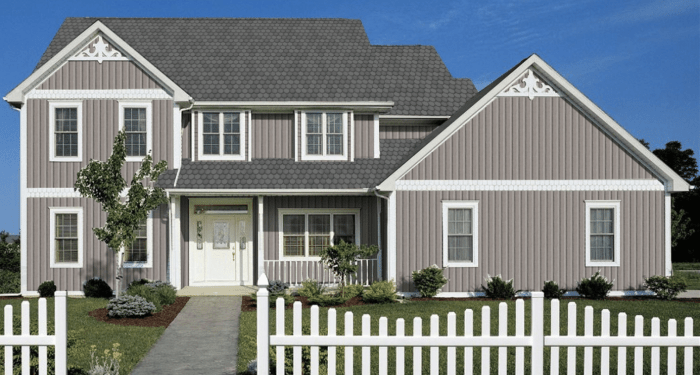Dive into the world of metal siding for houses, where durability meets energy efficiency and low maintenance. Discover how this versatile material can transform your home.
Learn about the different types of metal siding, the installation process, and essential maintenance tips to keep your siding looking pristine.
. Use tin snips to cut the panels to the correct size.
Benefits of Metal Siding for Houses
Metal siding offers a range of benefits that make it a popular choice for homeowners looking for a durable and energy-efficient option that requires minimal maintenance.Durability
Metal siding is known for its exceptional durability, standing up well to harsh weather conditions such as strong winds, heavy rain, and snow. Unlike materials like wood or vinyl, metal siding does not rot, warp, or crack over time, ensuring a long-lasting exterior for your home.Energy Efficiency
Metal siding can enhance the energy efficiency of homes by providing an additional layer of insulation. This helps to regulate indoor temperatures, reducing the need for heating and cooling systems to work overtime. Additionally, some metal siding options are designed to reflect sunlight, minimizing heat absorption and keeping homes cooler in warmer months.Low Maintenance
One of the key advantages of metal siding is its low maintenance requirements. Unlike wood siding that needs regular painting or staining, metal siding typically only requires occasional cleaning with soap and water to maintain its appearance. This can save homeowners time and money on upkeep in the long run.Types of Metal Siding
Metal siding comes in various types, each offering unique benefits and aesthetic options for houses.Steel Siding
Steel siding is a popular choice for its durability and strength. It is resistant to dents and offers excellent protection against the elements. Steel siding is available in a wide range of colors and finishes, allowing homeowners to customize their exterior look. While steel siding tends to be more expensive upfront, its longevity and low maintenance requirements make it a cost-effective option in the long run.Aluminum Siding
Aluminum siding is lightweight and corrosion-resistant, making it a suitable choice for coastal areas or regions with high humidity. It is available in various colors and finishes, offering versatility in design options. Aluminum siding is generally more affordable than steel siding, making it a budget-friendly alternative for homeowners looking for a durable and attractive siding option.Zinc Siding
Zinc siding is known for its natural weathering process, which creates a unique patina over time. This type of siding is eco-friendly and requires minimal maintenance. Zinc siding is available in shades of gray, providing a modern and sleek look to homes. While zinc siding may have a higher initial cost, its longevity and sustainability make it a valuable investment for environmentally conscious homeowners.Installation Process of Metal Siding
Metal siding installation involves several steps to ensure a proper and long-lasting finish on a house. It is important to follow these steps carefully and use the appropriate tools for the job.Gather the Necessary Tools and Materials:
- Hammer
- Tin snips
- Level
- Tape measure
- Drill
- Screws
- Ladder
- Safety gear
Prepare the Surface:
Before installing the metal siding, it is essential to prepare the surface by removing any old siding, cleaning the area, and ensuring it is smooth and dry.Measure and Cut the Siding:
Accurate measurements are crucial when cutting the metal siding to fit the dimensions of the houseInstall the Siding:
Start at the bottom of the wall and work your way up, overlapping each panel to prevent water from seeping in. Use screws to secure the panels in place, making sure they are level and properly aligned.Finish the Edges:
Use J-channels and corner pieces to finish the edges and give the siding a polished look. These accessories also help protect the edges from damage.Maintenance and Care for Metal Siding
Metal siding is a durable and low-maintenance option for houses, but it still requires some care to keep it looking its best and to prolong its lifespan.Cleaning Metal Siding
Regular cleaning is essential to maintain the appearance and integrity of metal siding. Here's how you can effectively clean metal siding:- Start by rinsing the siding with a garden hose to remove loose dirt and debris.
- Prepare a solution of mild detergent and water.
- Use a soft-bristled brush or a cloth to gently scrub the siding with the soapy solution.
- Rinse the siding thoroughly with clean water to remove any soap residue.
- For tougher stains, you can use a mixture of vinegar and water or a specialized metal siding cleaner.
- Avoid using abrasive materials or harsh chemicals that could damage the siding.
Maintenance Practices
By following some common maintenance practices, you can help prolong the lifespan of your metal siding:- Inspect the siding regularly for signs of damage, such as dents, scratches, or rust.
- Touch up any chipped paint or scratches to prevent rust from forming.
- Ensure proper drainage to prevent water from getting trapped behind the siding, which can lead to corrosion.
- Trim back any vegetation that is in contact with the siding to prevent damage and promote airflow.
- Check for loose or missing fasteners and replace them as needed to keep the siding securely in place.
Repairing Damages
If your metal siding sustains minor damages or dents, you can attempt to repair them yourself:- For small dents, use a rubber mallet to gently tap the metal back into place.
- Repaint the affected area to protect it from rust and blend it with the rest of the siding.
- If the damage is more severe, consider hiring a professional to assess and repair the siding.















